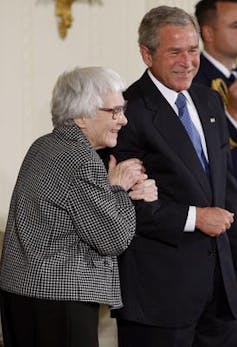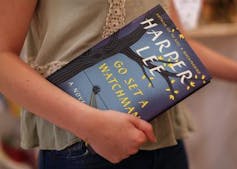Editorial To Kill A Mockingbird
In our serial, Guide to the classics, experts explain key works of literature.
Harper Lee'due south To Kill A Mockingbird is ane of the classics of American literature. Never out of print, the novel has sold over 40 million copies since it was first published in 1960. Information technology has been a staple of high school syllabuses, including in Australia, for several decades, and is often deemed the archetypal race and coming-of-age novel. For many of us, it is a formative read of our youth.
Baca juga: 'Great books', nationhood and teaching English literature
The story is set in the sleepy Alabama boondocks of Maycomb in 1936 - twoscore years after the Supreme Courtroom's notorious declaration of the races as being "dissever but equal", and 28 years before the enactment of the Civil Rights Act. Our narrator is nine-year-erstwhile tomboy, Scout Finch, who relays her observations of her family unit's struggle to bargain with the class and racial prejudice shown towards the local African American community.

At the eye of the family and the novel stands the highly principled lawyer Atticus Finch. A widower, he teaches Scout, her older brother Jem, and their imaginative friend Dill, how to alive and acquit honourably. In this he is aided by the family's hardworking and sensible blackness housekeeper Calpurnia, and their kind and generous neighbour, Miss Maudie.
It is Miss Maudie, for case, who explains to Lookout why information technology is a sin to kill a mockingbird: "Mockingbirds don't do one affair but brand music for the states to enjoy. They don't consume upwards people's gardens, don't nest in corncribs, they don't do ane thing but sing their hearts out for the states."
Throughout the novel, the children grow more aware of the community's attitudes. When the book begins they are preoccupied with catching sight of the mysterious and much feared Boo Radley, who in his youth stabbed his male parent with a pair of scissors and who has never come up out of the family house since. And when Atticus agrees to defend Tom Robinson, a black human being who is falsely accused of raping a white woman, they likewise become the target of hatred.
A morality tale for modern America
One might look a volume that dispatches moral lessons to be dull reading. But To Kill a Mockingbird is no sermon. The lessons are presented in a seemingly effortless style, all the while tackling the complexity of race problems with startling clarity and a strong sense of reality.
Baca juga: William Faulkner diagnosed modern ills in Every bit I Lay Dying
Every bit the Finches render from Robinson's trial, Miss Maudie says: "as I waited I thought, Atticus Finch won't win, he can't win, but he'due south the only homo in these parts who can continue a jury out so long in a case like that."
Despite the tragedy of Robinson's conviction, Atticus succeeds in making the townspeople consider and struggle with their prejudice.
The effortlessness of the writing owes much to the way the story is told. The narrator is a grown Scout, looking back on her childhood. When she begins her story, she seems more interested in telling the states nigh the people and incidents that occupied her 6-year-old imagination. But slowly does she come up to the events that changed everything for her and Jem, which were ready in motion long before their time. Fifty-fifty then, she tells these events in a way that shows she too immature to e'er grasp their significance.
The lessons Lee sets out are encapsulated in episodes that are equally funny as they are serious, much like Aesop's Fables. A case in point is when the children return abode from the school concert with Scout nevertheless dressed in her outlandish ham costume. In the dark they are chased and attacked by Bob Ewell the father of the woman whom Robinson allegedly raped. Ewell, armed with a knife, attempts to stab Scout, only the shapeless wire cage of the ham causes her to loose residual and the knife to go off-target. In the struggle that ensues someone pulls Ewell off the teetering torso of Sentry and he falls on the knife. It was Boo Radley who saved her.
Another lesson about what it means to be truly brave is delivered in an enthralling episode where a local farmer's domestic dog of a sudden becomes rabid and threatens to infect all the townsfolk with his deadly drool.
Scout and Jem are surprised when their bespectacled, bookish father turns out to take a "God-given talent" with a rifle; it is he who fires the single shot that volition render the townsfolk rubber. The children rejoice at what they consider an impressive display of courage. However, he tells them that what he did was not truly brave. The meliorate example of courage, he tells them, is Mrs Dubose (the "mean" old lady who lived down the road), who managed to cure herself of a morphine addiction fifty-fifty as she was dying a horribly painful death from cancer.

He too teaches them the importance of behaving in a civilised manner, even when subjected to insults. Well-nigh of all Atticus teaches the children the importance of listening to 1'southward conscience even when everyone else holds a contrary view: "The one matter that doesn't abide by majority rule", he says, "is a person'due south conscience."
The continuing value in Atticus' belief in the importance of principled thinking in the earth of Black Lives Matter and the Australian government's rhetoric of "African gangs", is clear.
Atticus' spiel on "conscience" and the other ethical principles he insists on living by, are primal to the enduring influence of the novel. It conjures an ideal of moral standards and human being behaviour that many people still aspire to today, fifty-fifty though the novel'southward events and the characters belong to the past.
Lee herself was not one to shy away from principled displays: writing to a school that banned her novel, she summed upwards the source of the morality her book expounds. The novel, she said, "spells out in words of seldom more than two syllables a code of honor and conduct".
Fame and obscurity
When first published the novel received rave reviews. A twelvemonth later information technology won the Pulitzer Prize for Literature, followed by a movie version in 1962 starring Gregory Peck. Indeed, the novel was such a success that Lee, unable to cope with all the attention and publicity, retired into obscurity.
Interviewed late in life, Lee cited ii reasons for her continued silence: "I wouldn't become through the pressure and publicity I went through with To Kill a Mockingbird for whatever corporeality of money. Second, I take said what I wanted to say, and I will not say information technology again."
The latter statement is doubtless a reference to the autobiographical nature of her book. Lee passed her babyhood in the rural town of Monroeville in the deep south, where her attorney father defended ii blackness men accused of killing a shopkeeper. The defendant were convicted and hanged.

Undoubtedly influenced by these determinative events, the biographical fiction Lee drew out of her family history became yet more than circuitous upon the publication of her merely other novel, Go Fix a Watchman, in 2016. Critics panned it it for defective the low-cal touch and humour of the first novel. They too decried the fact that the character of Atticus Finch was this time around a racist bigot, a characteristic that had the potential to taint the author's legacy.
Baca juga: Review/ Has Get Set a Watchman helped topple the notion of the white saviour?
Subsequent biographical research revealed that Go Set up A Watchman, was non a sequel, simply the first typhoon of To Kill a Mockingbird. Following initial rejection past the publisher Lippincot, Lee reworked it into the superior novel many of united states know and all the same dear today.
Lee gave us the portrait of one modest town in the due south during the low years. Merely it was and so filled with lively item, and unforgettable characters with unforgettable names like Atticus, Scout, Calpurnia and Boo Radley that a universal story emerged, and with it the novel's continuing popularity.
Editorial To Kill A Mockingbird,
Source: https://theconversation.com/how-the-moral-lessons-of-to-kill-a-mockingbird-endure-today-100763
Posted by: isaacslact1943.blogspot.com


0 Response to "Editorial To Kill A Mockingbird"
Post a Comment